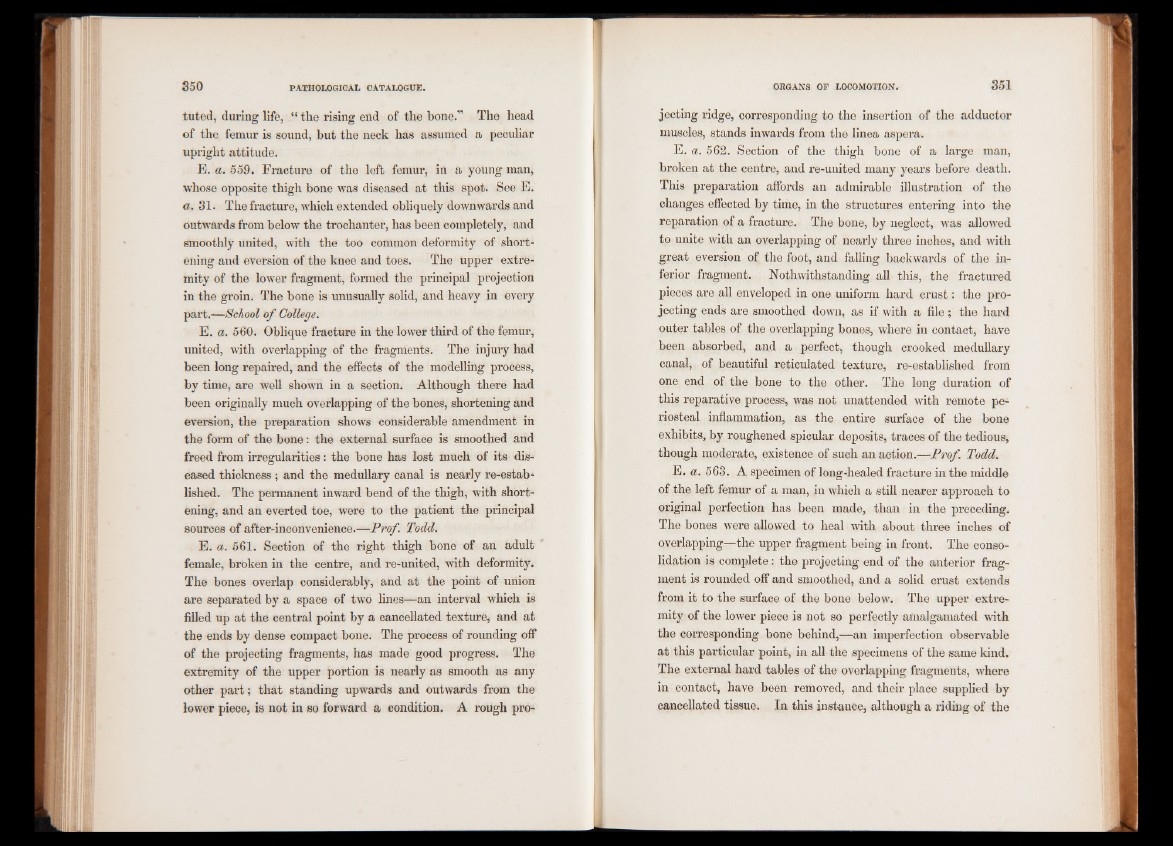
tuted, during life, “ the rising end of the bone.” The head
of the femur is sound, but the neck has assumed a peculiar
upright attitude.
E. a. 559. Fracture of the left femur, in a young man,
whose opposite thigh bone was diseased at this spot. See E.
a. 31. The fracture, which extended obliquely downwards and
outwards from below the trochanter, has been completely, and
smoothly united, with the too common deformity of shortening
and eversion of the knee and toes. The upper extremity
of the lower fragment, formed the principal projection
in the groin. The bone is unusually solid, and heavy in every
part.—School of College.
E. a. 560. Oblique fracture in the lower third of the femur,
united, with overlapping of the fragments. The injury had
been long repaired, and the effects of the modelling process,
by time, are well shown in a section. Although there had
been originally much overlapping of the bones, shortening and
eversion, the preparation shows considerable amendment in
the form of the bone: the external surface is smoothed and
freed from irregularities: the bone has lost much of its diseased
thickness; and the medullary canal is nearly re-established.
The permanent inward bend of the thigh, with shortening,
and an everted toe, were to the patient the principal
sources of after-inconvenience.—Prof. Todd.
E. a. 561. Section of the right thigh bone of an adult
female, broken in the centre, and re-united, with deformity.
The bones overlap considerably, and at the point of union
are separated by a space of two lines—an interval which is
filled up at the central point by a cancellated texture, and at
the ends by dense compact bone. The process of rounding off
of the projecting fragments, has made good progress. The
extremity of the upper portion is nearly as smooth as any
other part; that standing upwards and outwards from the
lower piece, is not in so forward a condition. A rough projecting
ridge, corresponding to the insertion of the adductor
muscles, stands inwards from the linea aspera.
E. a. 562. Section of the thigh bone of a large man,
broken at the centre, and re-united many years before death.
This preparation affords an admirable illustration of the
changes effected by time, in the structures entering into the
reparation of a fracture. The bone, by neglect, was allowed
to unite with an overlapping of nearly three inches, and with
great eversion of the foot, and falling backwards of the inferior
fragment. Nothwithstanding all this, the fractured
pieces are all enveloped in one uniform hard crust: the projecting
ends are smoothed down, as if with a file; the hard
outer tables of the overlapping bones, where in contact, have
been absorbed, and a perfect, though crooked medullary
canal, of beautiful reticulated texture, re-established from
one end of the bone to the other. The long duration of
this reparative process, was not unattended with remote periosteal
inflammation, as the entire surface of the bone
exhibits, by roughened spicular deposits, traces of the tedious,
though moderate, existence of such an action.—Prof. Todd.
E. a. 563. A specimen of long-healed fracture in the middle
of the left femur of a man, in which a still nearer approach to
original perfection has been made, than in the preceding.
The bones were allowed to heal with about three inches of
overlapping—the upper fragment being in front. The consolidation
is complete: the projecting end of the anterior fragment
is rounded off and smoothed, and a solid crust extends
from it to the surface of the bone below. The upper extremity
of the lower piece is not so perfectly amalgamated with
the corresponding bone behind,—an imperfection observable
at this particular point, in all the specimens of the same kind.
The external hard tables of the overlapping fragments, where
in contact, have been removed, and their place supplied by
cancellated tissue. In this instance, although a riding of the